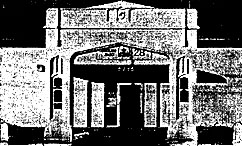 |
|
Cumberland heritage |

|
Comox, British Columbia
 Exerpt from Cumberland heritage: A selected history of people, buildings, institutions and
sites, 1918 -1950.
Exerpt from Cumberland heritage: A selected history of people, buildings, institutions and
sites, 1918 -1950.
by Jennifer Nell Bar;
Corporation of the City of Cumberland,p129-131.
Cumberland heritage
Comox, British Columba
This year (1997), the Town of Cumberland has made the arch and the front 14 bollards and chain a historic site.
Later this year, the Canadian Scots Regiment from Victoria, British Columbia, are placing a tablet in memory of
local men and women who served with the Canadian Scots.
Great War Veterans' Association (GWVA)
On 11 November 1918, the day Armistice was signed in France to end World War I (WWI), Cumberland was in the middle of
the Spanish Influenza epidemic. All public places were closed by order of city council. However, at two o'clock in
the morning, the church bells and fire bell began ringing, and the whistles of the locomotives in the WCR round house
began blowing. The phones rang throughout town, the city lit up and, by five o'clock, the citizens of Cumberland were
celebrating in the streets and decorating Dunsmuir Avenue.
On the first anniversary of Armistice Day in 1919, the citizens celebrated with a masquerade ball, which was hailed as
the "first annual". Although the balls continued for several years on another day, by 1920 it was felt that it would
be more fitting to commemorate 11 November with a memorial ceremony to the dead rather than with a celebration.
In 1919, the city showed its appreciation to the men who had gone overseas to fight by giving a lot to GWVA so they could
build a Memorial Hall. The hall, designed by William Arthur Owen and built by H. Trehearne of Courtenay, was
officially opened in October 1920. A dance hall, added in March 1922, was used by many organizations for banquets and
formal functions.
In 1921, the GWVA built a Memorial Arch in front of the Hall. On this Arch, they placed tablets with the names of 28
local people, including two Japanese-Canadians, who lost their lives in the service of their country during WWI. This
Arch was also designed by Owen, and the bronze tablets were manufactured by Henry Birks and Sons, Montreal.
Following WWII, the names of the 15 locals who died in that conflict were placed on the Arch, as was a later plaque
honouring all local Korean War veterans. Those who died have a maple leaf beside their names.
The Tudor-arch shape of the main structure of the Memorial Arch is echoed in three inset panels at the top and long
panels down the front sides. The Arch, in turn, echoed the front entrance and window shapes on the Memorial Hall. The
original roughcast stucco gave much more definition to the recessed forms than the modern flat-coloured stucco.
The poured concrete bollards linked with heavy chains which outline the property are contemporary with the arch, although
the ground level around them had risen.
The GWVA became the Royal Canadian Legion of the British Empire Service League in 1926, and Cumberland Branch was
instituted as No.28. When the original Memorial Hall was gutted by fire on 17 April 1962, it was replaced by a smaller,
one-storey concrete block building.
|